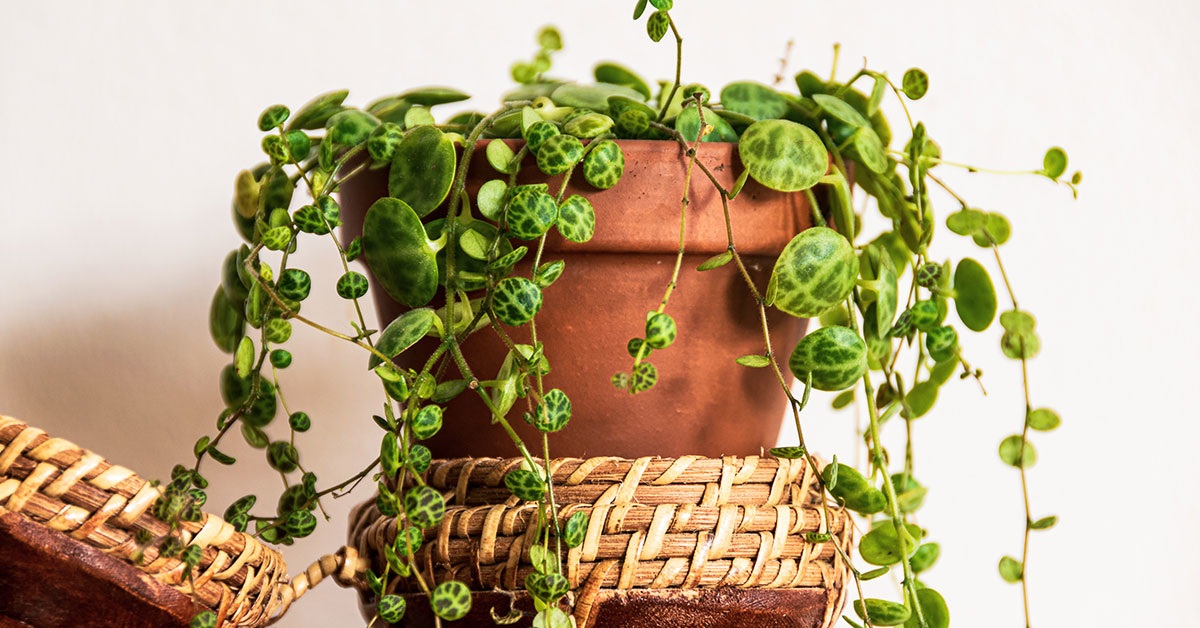A String of Turtles (Peperomia prostrata) is a type of succulent plant that is native to Central and South America. You can find this plant in its habitat attached to other trees. It has gotten very popular in recent years for its long, trailing stems and small, oval-shaped leaves that look like tiny turtle shells. This easy-to-care-for plant prefers to be kept in bright, indirect sunlight and is allowed to dry out between waterings. It can be propagated by stem cuttings and can be used in both indoor and outdoor containers. They are slow growers, so be patient!
The string of turtles prefers lots of indirect light but be sure to place it somewhere that the top of the plant can also get light. This will ensure a stronger plant with healthier color. You won’t need to prune it often but feel free to cut away any unruly, leggy, or dying branches.
Propagate a String of Turtles
Propagating a String of Turtles is a simple process that can be done in several different ways. They can be cultivated with a cut branch, air layering, or as a last resort, their leaves. If you are short on soil then you can use water to get them sprouting as well. We’ll walk you through the all steps, explaining the process and benefits below.
By Cutting
Growing a String of Turtles from a cutting is the most successful way to propagate one. Take a pair of clean, sharp scissors and take a stem cutting from a mature plant. You’ll want it to be at least 4-6 inches in length. Remove any leaves from the base of the cutting, making sure to leave the nodes. You can dip the end of the cutting in the rooting hormone but this isn’t necessary. You are now ready to root your little guy in water or soil.
Starting a String of Turtles Cutting in Soil
There are two ways to get your pant to root. You can either bury the base of the cutting in soil or lay it on top and let the roots sink. Both are fine options and both require the same soil. You’ll want fast-draining soil, standing water is a String of Turtles killer. We recommend using a potting mix with peat, coco coir, earthworm castings, or other organic material. You can also use commercial cactus or succulent mix.
Take your cutting and place it at least 1/2 inch-1 inch into the soil. There should be one node under the soil line. Water generously and place the plant in a brightly light area with plenty of indirect light. Alternatively, you can simply lay your cutting on top of moist soil making sure that the nodes have strong contact with the soil.
For both of these options be wary of over-watering, and keep the top layer moist while they are rooting. For the brave-hearted, you can give your cutting an incredibly gentle tug after about a month to feel for resistance. Once the root system has been developed you may treat it like a mature plant.
Air Layering a String of Turtles
As we mentioned earlier, this dangling plant is found on the sides of trees and other plants. This means that they will naturally root when their tendrils find suitable soil. This process requires no cutting, just suitable moist soil, and patience. Prepare a pot with well-draining soil and place that pot close enough that you can drape a tendril over the pot, touching the soil. Continue to care for the parent plant while keeping the soil of the new plant moist.
Watch the new plant closely, in about 1-2 weeks you will see roots start to form. Once roots are visible cut the tendril from the parent plant and use a hairpin or bread tie to anchor the plant down to the soil. Use a clean pair of scissors and cut sever the tendril connecting the two. Care for your new plant as though it is mature. While this process is not the surest way to propagate, it is very safe as you are not cutting anything off. It is also incredibly cool to watch!
Starting a String of Turtles Cutting in Water
Propagating Sting of Turtles in water is fascinating to watch and has a great success rate. Take your cutting and place it in a container with water. Ensure that at least one node is submerged in water. Place the container in a brightly lit area with lots of indirect light. Change the water weekly or when the water starts to get dirty and clouded.
After 1-2 months your roots should be around 2 to 3 inches long. Once they are, prepare the same soil used in the earlier methods. Dig a small hole in the soil large enough to place the base of your cutting and its roots in without bunching them up. cover the roots and water. This plant is now considered mature.
How to Propagate a String of Turtles Using a Leaf
Propagating a String of Turtles for leaves should always be a last resort. The success rate of the rooting can be sketchy at best and can take up to 3 months to complete. However, you have to work with what you have, so let’s get into it. Using a clean, sharp pair of scissors or blade, remove a few leaves from the main stem. Be sure to leave the stem of the leaf connected to the leaf. Place one leaf per container, with the stem below the soil level. Do not bury the whole leaf. Keep the top layer moist and the plant bright, with indirect lighting. Be patient with this method, it can take much longer than the others.













